Abstract
Formation of lipid peroxides rises sharply when platelets undergo the release reaction. In this study the in vitro effect of vitamin E on platelet aggregation was investigated. alpha-Tocopherol, an anitoxidant of known inhibitory action on lipid peroxidation, was added to platelet suspensions in concentrations up to 1.5 mM. A dose-dependent reduction in platelet aggregation was observed, with complete inhibition of the secondary wave of aggregation at greater than or equal to 0.9 mM alpha-tocopherol. The inhibitory effect of alpha-tocopherol on the platelet release reaction was further documented by the decrease in aggregation-induced release of [14C]5-hydroxytryptamine from prelabeled platelets and by the reduction of N-acetylglucosaminidase activity released into the medium. The sharp rise in lipid peroxides normally associated with platelet aggregation was markedly reduced by alpha-tocopherol and also by acetylsalicylic acid, a known inhibitor of the platelet release reaction. In vivo studies examined the effect of oral vitamin E administration (1,200-2,400 IU daily) on plasma and platelet levels of alpha-tocopherol. Up to 1,800 IU daily, increasing dosages of vitamin E resulted in increasing concentrations of alpha-tocopherol in plasma and platelets, but intake of vitamin E in excess of this dosage failed to show any further increase in plasma or platelet levels.
Full text
PDF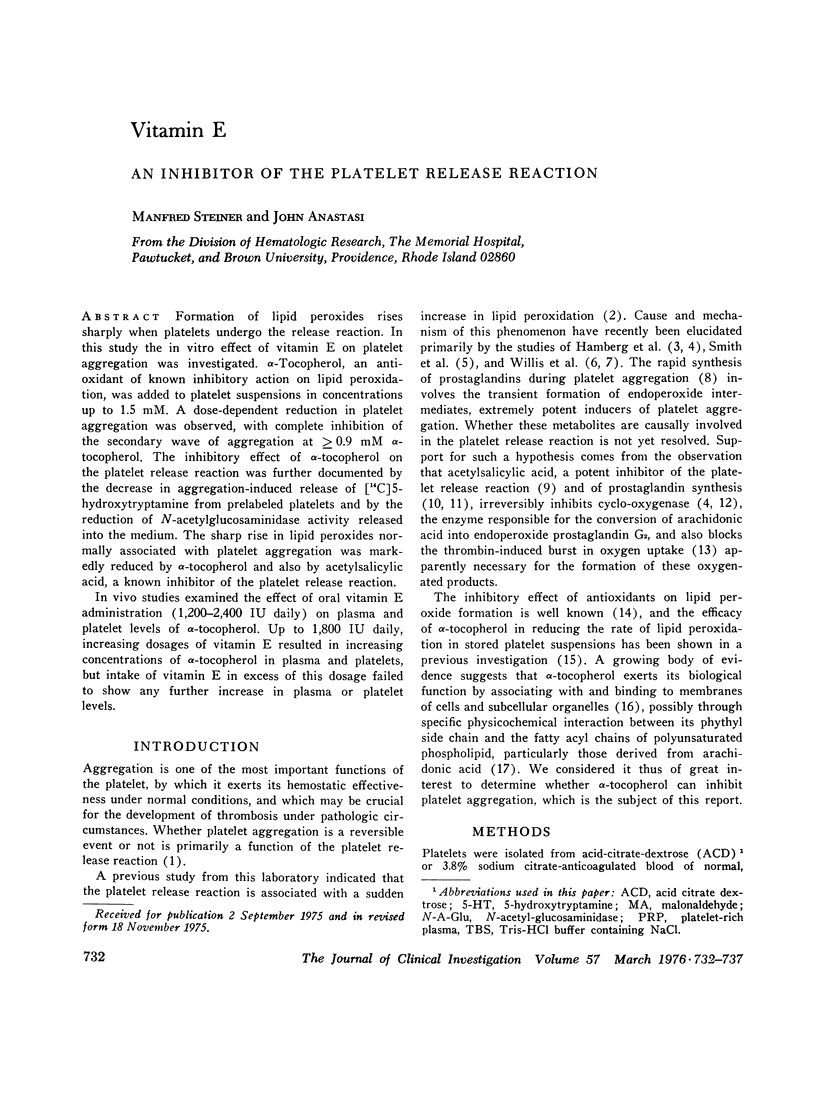
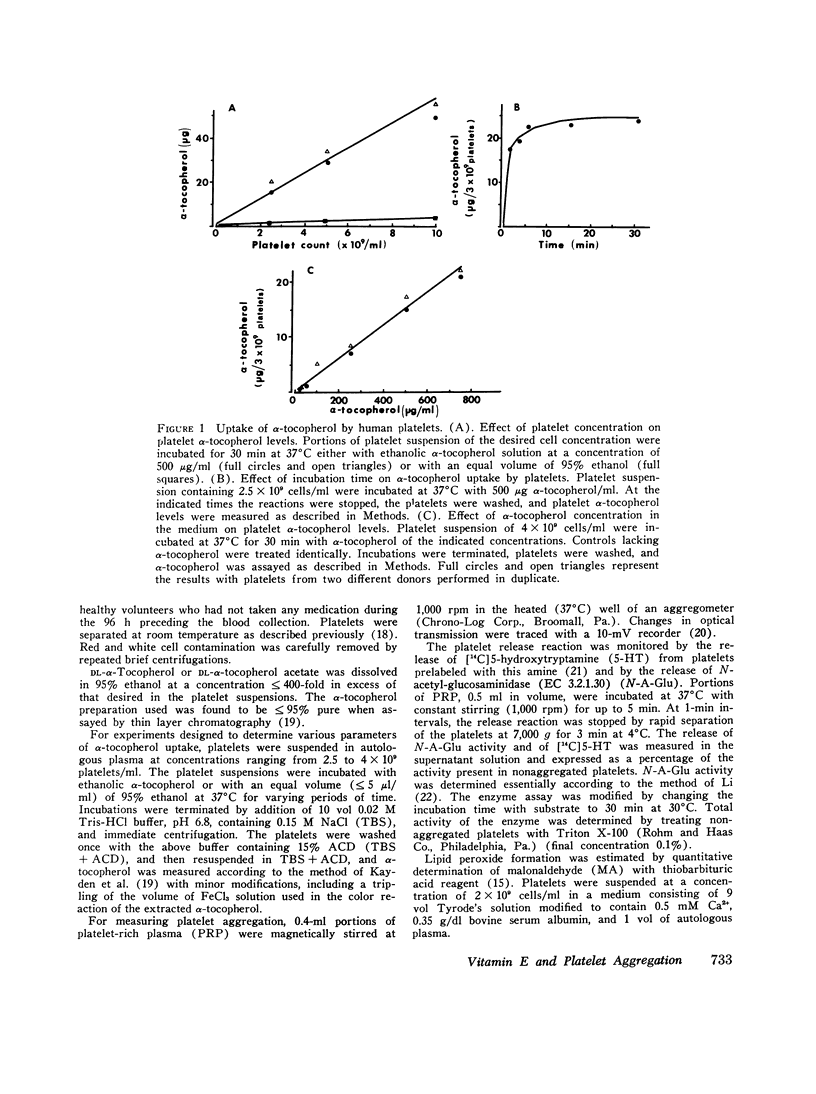
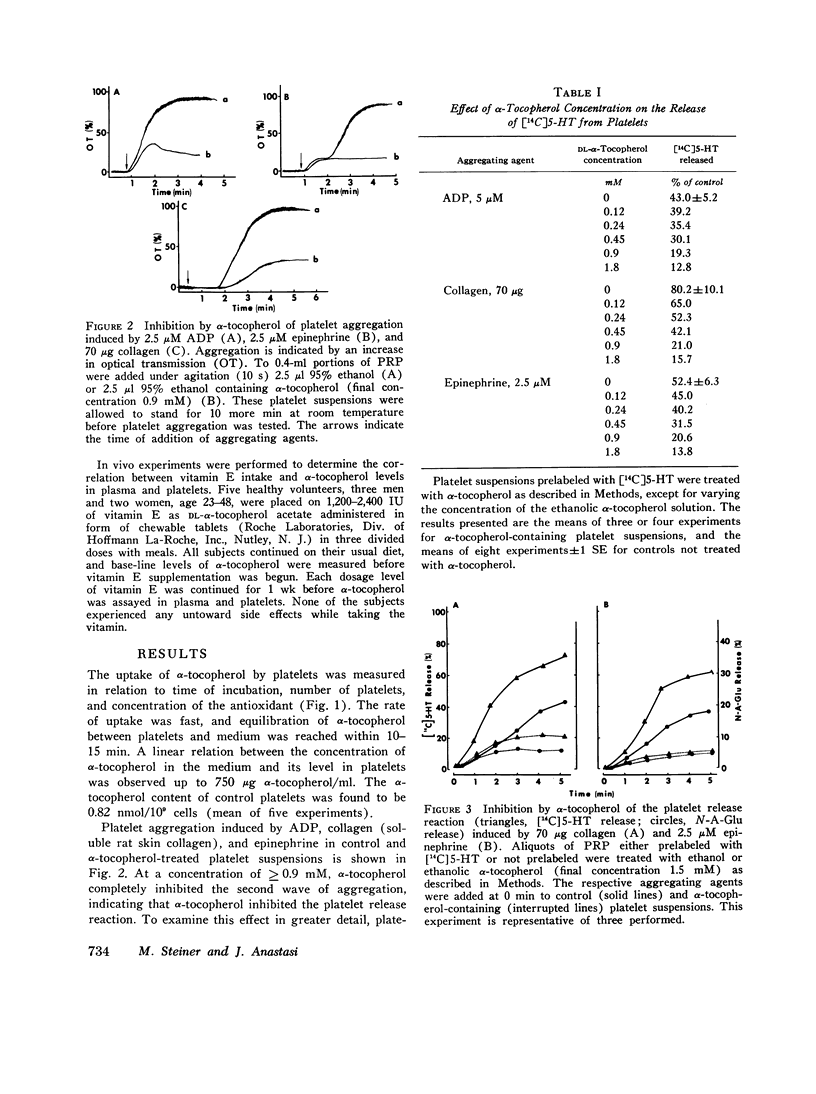
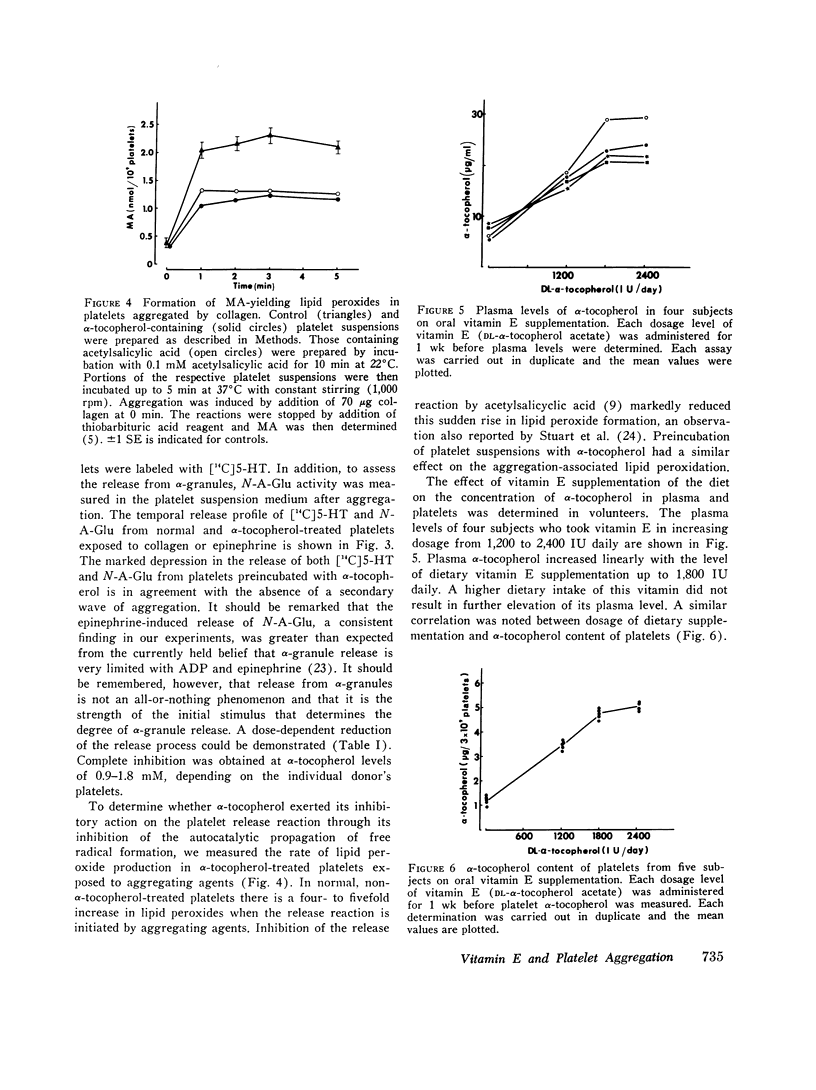
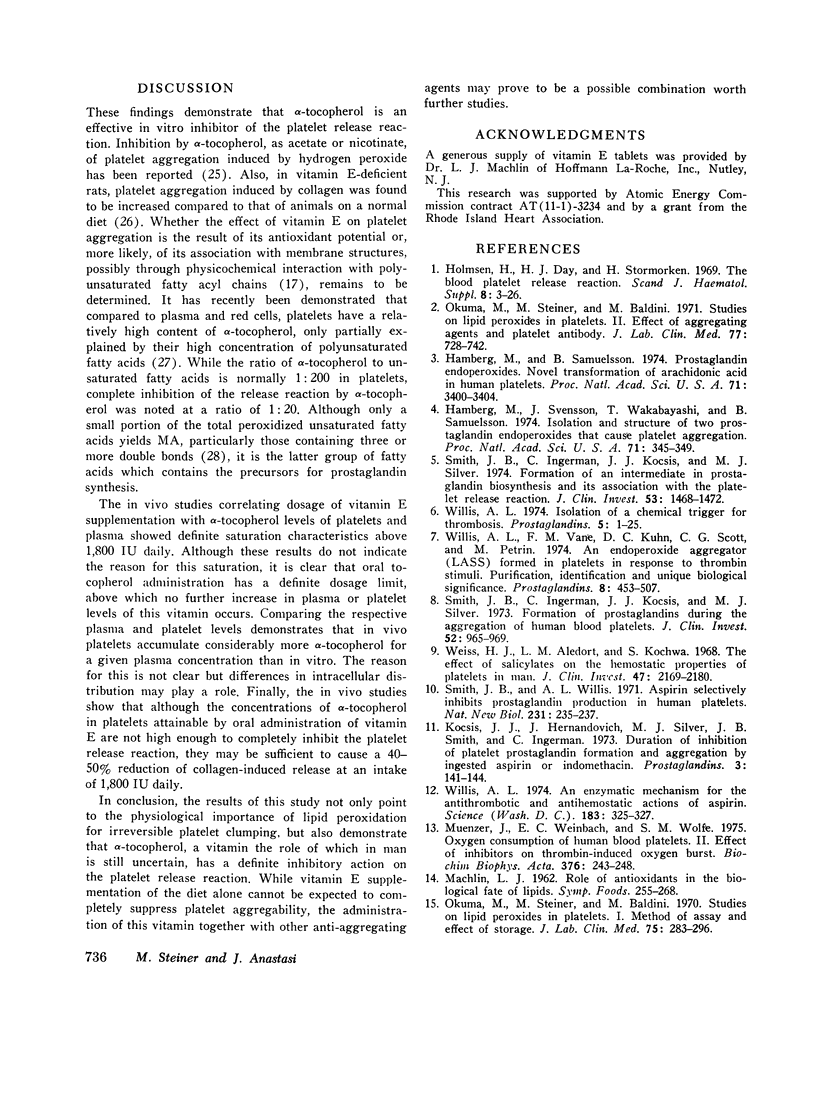
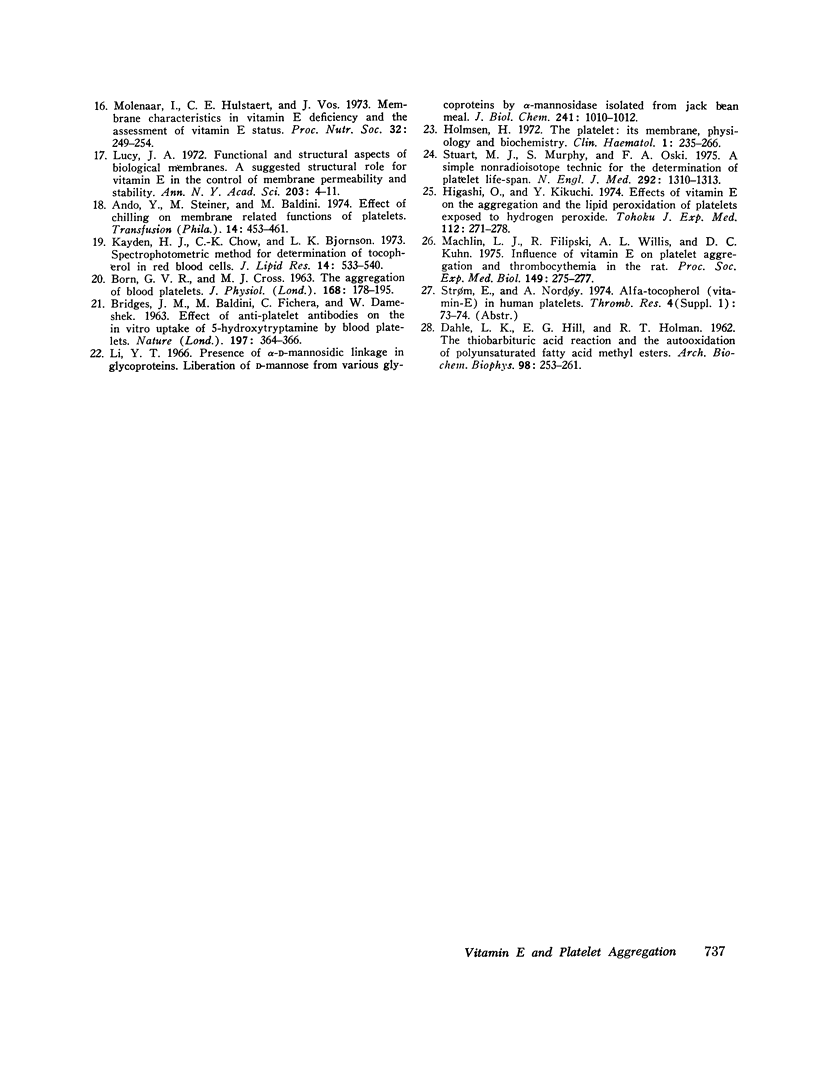
Selected References
These references are in PubMed. This may not be the complete list of references from this article.
- Ando Y., Steiner M., Baldini M. Effect of chilling on membrane related functions of platelets. Transfusion. 1974 Sep-Oct;14(5):453–461. doi: 10.1111/j.1537-2995.1974.tb04560.x. [DOI] [PubMed] [Google Scholar]
- BORN G. V., CROSS M. J. THE AGGREGATION OF BLOOD PLATELETS. J Physiol. 1963 Aug;168:178–195. doi: 10.1113/jphysiol.1963.sp007185. [DOI] [PMC free article] [PubMed] [Google Scholar]
- BRIDGES J. M., BALDINI M., FICHERA C., DAMESHEK W. Effect of anti-platelet antibodies on the in vitro uptake of 5-hydroxytryptamine by blood platelets. Nature. 1963 Jan 26;197:364–366. doi: 10.1038/197364a0. [DOI] [PubMed] [Google Scholar]
- DAHLE L. K., HILL E. G., HOLMAN R. T. The thiobarbituric acid reaction and the autoxidations of polyunsaturated fatty acid methyl esters. Arch Biochem Biophys. 1962 Aug;98:253–261. doi: 10.1016/0003-9861(62)90181-9. [DOI] [PubMed] [Google Scholar]
- Hamberg M., Samuelsson B. Prostaglandin endoperoxides. Novel transformations of arachidonic acid in human platelets. Proc Natl Acad Sci U S A. 1974 Sep;71(9):3400–3404. doi: 10.1073/pnas.71.9.3400. [DOI] [PMC free article] [PubMed] [Google Scholar]
- Hamberg M., Svensson J., Wakabayashi T., Samuelsson B. Isolation and structure of two prostaglandin endoperoxides that cause platelet aggregation. Proc Natl Acad Sci U S A. 1974 Feb;71(2):345–349. doi: 10.1073/pnas.71.2.345. [DOI] [PMC free article] [PubMed] [Google Scholar]
- Higashi O., Kikuchi Y. Effects of vitamin E on the aggregation and the lipid peroxidation of platelets exposed to hydrogen peroxide. Tohoku J Exp Med. 1974 Mar;112(3):271–278. doi: 10.1620/tjem.112.271. [DOI] [PubMed] [Google Scholar]
- Holmsen H., Day H. J., Stormorken H. The blood platelet release reaction. Scand J Haematol Suppl. 1969;8:3–26. [PubMed] [Google Scholar]
- Kayden H. J., Chow C. K., Bjornson L. K. Spectrophotometric method for determination of tocopherol in red blood cells. J Lipid Res. 1973 Sep;14(5):533–540. [PubMed] [Google Scholar]
- Kocsis J. J., Hernandovich J., Silver M. J., Smith J. B., Ingerman C. Duration of inhibition of platelet prostaglandin formation and aggregation by ingested aspirin or indomethacin. Prostaglandins. 1973 Feb;3(2):141–144. doi: 10.1016/0090-6980(73)90081-6. [DOI] [PubMed] [Google Scholar]
- Li Y. T. Presence of alpha-D-mannosidic linkage in glycoproteins. Liberation of d-mannose from various glycoproteins by alpha-mannosidase isolated from jack bean meal. J Biol Chem. 1966 Feb 25;241(4):1010–1012. [PubMed] [Google Scholar]
- Lucy J. A. Functional and structural aspects of biological membranes: a suggested structural role for vitamin E in the control of membrane permeability and stability. Ann N Y Acad Sci. 1972 Dec 18;203:4–11. doi: 10.1111/j.1749-6632.1972.tb27849.x. [DOI] [PubMed] [Google Scholar]
- Machlin L. J., Filipski R., Willis A. L., Kuhn D. C., Brin M. Influence of vitamin E on platelet aggregation and thrombocythemia in the rat. Proc Soc Exp Biol Med. 1975 May;149(1):275–277. doi: 10.3181/00379727-149-38787. [DOI] [PubMed] [Google Scholar]
- Molenaar I., Hulstaert C. E., Vos J. Membrane characteristics in vitamin E deficiency and the assessment of vitamin E status. Proc Nutr Soc. 1973 Dec;32(3):249–254. doi: 10.1079/pns19730047. [DOI] [PubMed] [Google Scholar]
- Muenzer J., Weinbach E. C., Wolfe S. M. Oxygen consumption of human blood platelets. II. Effect of inhibitors on thrombin-induced oxygen burst. Biochim Biophys Acta. 1975 Feb 17;376(2):243–248. doi: 10.1016/0005-2728(75)90016-x. [DOI] [PubMed] [Google Scholar]
- Okuma M., Steiner M., Baldini G. Studies on lipid peroxides in platelets. II. Effect of aggregating agents and platelet antibody. J Lab Clin Med. 1971 May;77(5):728–742. [PubMed] [Google Scholar]
- Okuma M., Steiner M., Baldini M. Studies on lipid peroxides in platelets. I. Method of assay and effect of storage. J Lab Clin Med. 1970 Feb;75(2):283–296. [PubMed] [Google Scholar]
- Smith J. B., Ingerman C., Kocsis J. J., Silver M. J. Formation of an intermediate in prostaglandin biosynthesis and its association with the platelet release reaction. J Clin Invest. 1974 May;53(5):1468–1472. doi: 10.1172/JCI107695. [DOI] [PMC free article] [PubMed] [Google Scholar]
- Smith J. B., Ingerman C., Kocsis J. J., Silver M. J. Formation of prostaglandins during the aggregation of human blood platelets. J Clin Invest. 1973 Apr;52(4):965–969. doi: 10.1172/JCI107262. [DOI] [PMC free article] [PubMed] [Google Scholar]
- Smith J. B., Willis A. L. Aspirin selectively inhibits prostaglandin production in human platelets. Nat New Biol. 1971 Jun 23;231(25):235–237. doi: 10.1038/newbio231235a0. [DOI] [PubMed] [Google Scholar]
- Strom E., Nordoy A. Alfa-tocopherol (vitamin-E) in human platelets. Thromb Res. 1974 Jun;4(0):suppl 1–1:74. doi: 10.1016/0049-3848(74)90155-8. [DOI] [PubMed] [Google Scholar]
- Stuart M. J., Murphy S., Oski F. A. A simple nonradioisotope technic for the determination of platelet life-span. N Engl J Med. 1975 Jun 19;292(25):1310–1313. doi: 10.1056/NEJM197506192922502. [DOI] [PubMed] [Google Scholar]
- Weiss H. J., Aledort L. M., Kochwa S. The effect of salicylates on the hemostatic properties of platelets in man. J Clin Invest. 1968 Sep;47(9):2169–2180. doi: 10.1172/JCI105903. [DOI] [PMC free article] [PubMed] [Google Scholar]
- Willis A. L. An enzymatic mechanism for the antithrombotic and antihemostatic actions of aspirin. Science. 1974 Jan 25;183(4122):325–327. doi: 10.1126/science.183.4122.325. [DOI] [PubMed] [Google Scholar]
- Willis A. L. Isolation of a chemical trigger for thrombosis. Prostaglandins. 1974 Jan 10;5(1):1–25. doi: 10.1016/s0090-6980(74)80126-7. [DOI] [PubMed] [Google Scholar]
- Willis A. L., Vane F. M., Kuhn D. C., Scott C. G., Petrin M. An endoperoxide aggregator (Lass), formed in platelets in response to thrombotic stimuli: purification, identification and unique biological significance. Prostaglandins. 1974 Dec 25;8(6):453–507. doi: 10.1016/0090-6980(74)90062-8. [DOI] [PubMed] [Google Scholar]


